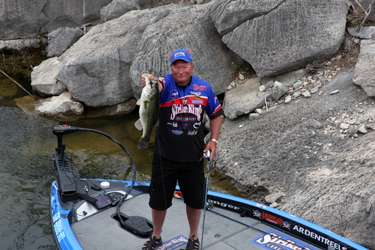
Over the course of my career, I've caught bass just about every way there is to catch them — from topwater to dragging the bottom with a Carolina rig — but most people seem to associate me with flipping and pitching. It's a fair label and one that I don't avoid. After all, several of my 16 career BASS tournament wins (including the 1998 Bassmaster Classic) came at the end of the long rod, and I think there's no better way to target big fish in shallow water than by pitching and flipping.
Thirty years ago, when flipping was still fairly new and pitching hadn't been invented, everyone carried just one rod style for the technique. It was 7 1/2-feet long and had all the action of a pool cue.
Today, however, we know better. Over the years, I've learned just how diverse flipping and pitching can be. I've fished with lots of different rods and reels and learned the shortcomings of each. One rod size and action doesn't cut it for me anymore, and if you're a flipper and pitcher, you should consider expanding your lineup to get more out of these techniques. Here's what I do:
The Rods
Just like everybody else, I once tried to use one action for all of my flipping and pitching. Boy, was that a mistake! The rod was too heavy for light lines and small baits, and it was too light for working extremely heavy wood and matted vegetation. The compromise was costing me fish.
Fortunately, one of my sponsors, American Rodsmiths, saw the same need, and we designed a three-rod lineup of flipping and pitching rods that will cover all the bases.
The Denny Brauer Flipping/Pitching Rod is 7 feet, 4 inches long and is a terrific all-around rod, but it's specially designed with a softer tip to handle lighter lines (17-20-pound test) and lighter baits. It's perfect for working boat docks or other areas where the cover's not as heavy or when you want a little more finesse in your approach.
Our Perfect Flipping Stick is 7-6 and is probably the model that I use most. The tip is light enough for smaller baits, but it's got enough backbone for mats. If you're getting only one rod for your flipping and pitching, I'd pick this one.
Finally, there's our "Big Nasty." It's a 7-7 rod that's perfectly suited for a style of flipping and pitching that's gaining in popularity every year — mat fishing. This rod is designed to yank big fish out of heavy cover. You wouldn't want to use light baits or line with this outfit, but you'll get tremendous hook penetration with the big hooks commonly used when pitching and flipping heavy cover.
One thing I want to mention about these rods is the new handle we're using. It's a softer handle than you're used to — very much like a golf club handle. It gives you a better grip — wet or dry — and once you use it you won't want to go back to cork or anything else. I'm addicted!
Now, for your personal flipping and pitching, you might not need all three rod types. Your waters might call for the lightest model or the heaviest, but I use all three because I travel the country and see all types of scenarios. Sometimes I've got all three of these rods on my deck and alternate between them depending on the cover I'm fishing. The tools you need depend on the situations in which you find yourself.
The Reel
While I use three different rod actions and lengths for my flipping and pitching, I only use one reel, the Ardent F-700 Flip-N-Pitch reel. It's a signature series reel I designed for Ardent, and the best flipping and pitching reel I've ever used.
The first thing you'll notice about the reel is that it has no levelwind. Instead, there's a cone at the nose of the reel and the lines passes through it. This reduces friction and lets you make longer pitches with less effort.
The spool is small and narrow. You don't need a lot of line for pitching and flipping; they're close-range tactics. But the F-700 has plenty of line if you want to make a cast. It's rated for 90 yards of 20-pound-test. If you think you need more line than that, we need to talk.
It has a flipping switch that will reengage the reel when you release the thumb bar, and it's fast at 6.3:1, so you'll pick up line quickly and be ready to make another presentation.
Another reason I'm so proud of the F-700 is the guts of the thing. We reworked the old Ardent F-500 and beefed it up with more and better ball bearings. There's no star drag on this reel, either. Instead, it has a Perma-Lock drag that's factory-set at 22 pounds so it won't slip on the hookset. It's the ultimate flipping and pitching reel.
Working with two different companies — American Rodsmiths and Ardent — to create the perfect flipping and pitching combo was a challenge, but it came together because they're both committed to being the best.
If you're ready to take your flipping and pitching to the next level, I hope you'll take a look at the products I've designed. No matter what, though, start thinking about pitching and flipping as being more versatile and wide-ranging than you may have in the past. These techniques have been around a long time now, but they're always evolving and improving. Our job is to keep imagining new ways to use them to become better anglers and catch more bass.
And remember: Give a flip!




